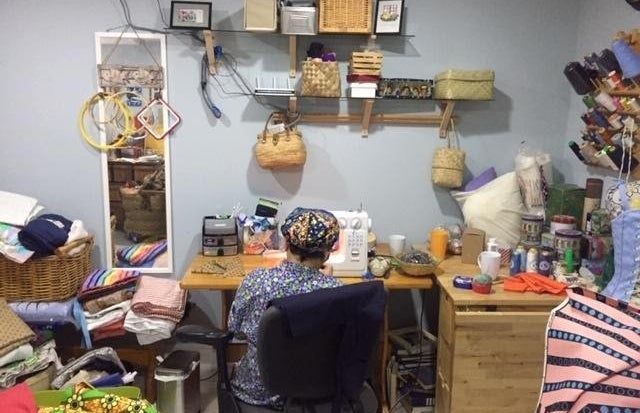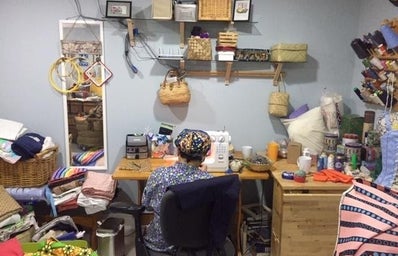Surrounded by rolls of print and pattern, loose threads, and pins – it serves as an appropriate visual metaphor for what must be going inside Maria Diego’s head. An endless chaos of snipping and stitching, she works like a well-oiled machine. Before the coronavirus pandemic, Diego signed up for Crochet for Cancer, a Canadian volunteer organization that makes handmade chemotherapy caps for patients that deal with hair loss.
“If I can make the caps for cancer patients, why can’t I do it for my co-workers?” Diego says. Amid the COVID-19 pandemic, Diego felt her skills could also be used in this timely manner.
Diego’s caps are both reversible and reusable. Last Sunday, she managed to turn over 25 surgical caps in the span of three days. But it’s not enough, Diego says.
Diego – who happens to be my mother – has always been a hard worker. She works long hours at her job, teaching students about critical care learning at George Brown College, and tries to keep up with household chores when she’s not at work. Diego doesn’t like to be idle, as she finds multiple ways to keep herself busy – by either sitting by the TV while knitting, baking bread, tending to the flowers in her garden, or making her latest sewing project.
Working on an increasingly unpredictable schedule – where she could be on the job for four days with one day off or four days work with three days off, Diego is in the midst of the battle against the coronavirus. She works as an ICU nurse at the Humber River Hospital. Lately, the hospital has been running out of medical supplies – more specifically, head caps to keep the hair insulated and protected. It isn’t the only hospital to face these shortages, as St. Joseph’s Health Centre in west Toronto to medical facilities in Windsor have also spoken out. Nurses and doctors are faced with the choice to reuse soiled protective equipment or to work without it.
On March 30, Ontario Premier Doug Ford spoke out during a press conference, and said the government is in the process of “securing massive, massive amounts of new inventory” for hospitals. Additionally, the federal government pledged $2 billion dollars towards medical supplies for healthcare workers nationwide the following day.
In the first few days within notice of this shortage, Diego is mindlessly sewing these head caps for a few of her colleagues. She’s quite an experienced sewer – familiar with making detailed quilts, tote bags, and collared shirts. It’s not difficult for her to make a simple cap, as exemplified by her clean seams and hems.
Diego says that she remembers the first day she had a nurse model a cap that she made. Soon after, more nurses have asked Diego to make caps for them as well.
But as the demand for reusable head caps grew, the more Diego was subjected to the basement, where her little sewing craft room is. She needed a pattern to accommodate bigger head sizes, women that had a lot of hair, and patterns for men that didn’t like the more feminine fabrics. Her stash of fabric – which she’s accumulated over the years by salvaging them at her local thrift store – has been slowly diminishing. As a result she’s asked the nurses to give her any fabric they may have lying around the house in exchange for a cap.
She doesn’t ask for money. “This is a time we have to do something for everyone. Nurses these days have a low morale because of the medical supply shortage,” she says. “If I can make a cap that could make a nurse feel better for a few minutes, then that would be okay.”
She’s been given high quality cotton prints, a yard of Batman themed fabric from a male nurse, and several yards of African print from another – priced at over a 100 dollars. “She says that after I give her one cap, I can give away the others I make from this fabric,” Diego says. “Initially, she wanted to make a dress out of it.” The fabric is a stained blue cotton decorated with gold detailing. The cap made out of this material has garnered the nickname ‘the queen cap,’ by Diego’s colleges.
The 25 caps she’s managed to make in a short amount of time “sold like hotcakes” on the day back from work. There are over 79 nurses in the ICU department, and she says that she’s nearly halfway from making everyone in her field a cap. In order to keep up with the demand, she’s tasked herself to make at least one head cap after she’s come home from work. After working a 12-hour shift, she drives home, eats dinner, and wastes no time as she descends back down to the basement to make more caps. The whir of the sewing machine is a steady hum throughout her house.
“I don’t get tired making caps all day because I have a goal,” Diego says. “It’s to give all my coworkers one cap at least.”



